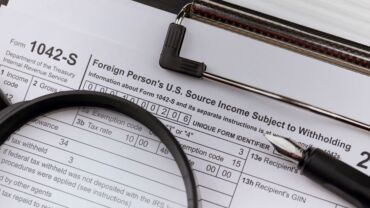Topic 326, Financial Instruments—Credit Losses, was a hot topic even before the coronavirus hit. After extensive implementation efforts, many public entities began to apply this standard as of January 1. As an accounting profession, we thought we had just gotten a handle on the new rules and how to apply them in practice.
Months later, a virus has permeated the globe and economies are faltering. Accountants must estimate expected credit losses on financial assets amidst extraordinary uncertainty.
Today, we’ll talk about possible accounting effects of the coronavirus when applying the current expected credit loss (CECL) model in Topic 326 to instruments measured at amortized cost. Topic 326 provides separate guidance for available-for-sale debt securities.
Applying Topic 326 in light of the coronavirus
Topic 326 requires accountants to estimate the expected credit losses on financial assets. The CECL model uses an allowance for credit losses. The allowance is an adjustment to the amortized cost basis of an asset, which results in presenting the net amount expected to be collected for the asset. Adjustments to the allowance are reported in net income as credit loss expense. An entity also includes expected recoveries in the allowance (although recoveries cannot exceed total amounts previously written off or expected to be written off).
Topic 326 does not require a specific method to determine the allowance for credit losses. Common methods used are discounted cash flow methods, loss-rate methods, roll-rate methods, probability-of-default methods, or methods based on aging of receivables. When determining the methods to estimate credit losses, a few things to consider are:
-
- Pools: When financial assets have similar risk characteristics, an entity measures expected credit losses on a collective (pool) basis. If a financial asset has unique risk characteristics, an entity measures expected credit losses on that asset individually. A few examples of risk characteristics are credit scores, credit ratings, risk classifications, collateral type, geographic location, and industry. The risk characteristics of many assets are changing due to the pandemic. Therefore, reporting entities must consider if pools need to be adjusted or if certain assets must be assessed individually. Likewise, reporting entities may have to revisit classes of financing receivables, which also depend, in part, on risk characteristics.
- Discounted cash flow methods: If an entity uses a discounted cash flow method, it must consider not only changes in the expected cash flows (such as principal and interest), but also changes in the discount rate. Topic 326 requires the discount rate to be the financial asset’s effective interest rate. A couple items to consider here are:
- If the financial asset’s contractual interest rate depends on an index or rate, the effective interest rate must incorporate actual changes in that index or rate. Topic 326 also discusses how to address projected changes in that index or rate. Due to the coronavirus, interest rates are moving. In particular, the Federal Reserve issued several emergency rate cuts.
- Topic 326 provides an accounting policy election under which a reporting entity can adjust the effective interest rate for expected prepayments. The election is made by class of financing receivable or major security type. Many businesses are strapped for cash, which may affect prepayments.
- Accrued interest receivables: Topic 326 provides an accounting policy election for accrued interest receivables. Specifically, a reporting entity can elect not to measure an allowance for credit losses if it writes off the uncollectible accrued interest receivables timely. If you have made this election, make sure you are continuing to write off uncollectible interest as appropriate.
- Off-balance-sheet credit exposures: Don’t forget that Topic 326 applies to off-balance-sheet credit exposures (such as loan commitments, standby letters of credit, and financial guarantees not accounted for as insurance). Therefore, you may need a method to estimate expected credit losses for off-balance-sheet credit exposures. Topic 326 does not apply to off-balance-sheet credit exposures accounted for as derivatives under Topic 815, Derivatives and Hedging.
- Purchased financial assets with credit deterioration (PCD assets): A PCD asset is a purchased asset that has experienced more than an insignificant decline in creditworthiness from the date of origination to the purchase date. Topic 326 provides special accounting guidance for PCD assets, including a requirement to add an allowance for expected credit losses to the purchase price to determine the initial amortized cost basis of the asset. As a result of the coronavirus, more assets that you purchase may meet the definition of a PCD asset.
We also need to talk about the information considered to estimate expected credit losses. An entity must estimate expected credit losses based on a variety of factors, including the borrower’s creditworthiness, changes in its lending strategies and underwriting practices, the current and forecasted economic and business environment, and loss information. Let’s explore these further:
- Borrower’s creditworthiness: The coronavirus has wreaked havoc on many industries such as travel, hospitality, construction, oil and gas, and restaurants. It may be difficult to predict the damage. Some businesses may struggle for an extensive period. However, depending on the situation, even borrowers in the hardest hit areas may be able to keep making payments. Until recent weeks, many businesses were thriving and may have resources to meet obligations. The question looms: how long will those resources last if current economic conditions persist or worsen? If borrowers have various operating segments, it may help to consider performance across all segments. Even though a borrower may be dragged down by one segment, it may have other segments to help mitigate the risk. Credit ratings are often a go-to metric to evaluate creditworthiness. Credit ratings may not have been updated to reflect current conditions and it may be some time before they catch up. Ultimately, judgment will be required in evaluating a borrower’s creditworthiness. Topic 326 also provides guidance on considering credit enhancements and financial assets secured by collateral.
- Changes in lending strategies and underwriting practices: Until a few weeks ago, the American economy was booming. The Dow Jones Industrial Average was in the longest bull market in history, setting its highest closing record just over a month ago. Things had been good for so long. When that happens, companies may tend to get more lax with their lending strategies or underwriting practices. If a reporting entity has softened its requirements, it may be at greater risk for credit losses.
- Economic and business environment: To estimate credit losses, an entity must consider both the current and forecasted direction of the economic and business environment. This is another area with extremely high uncertainty due to the pandemic. At present, many businesses have been forced to shut down temporarily to help slow the spread of the coronavirus. No one can predict how long those shutdowns will last or how customers will react when businesses reopen. Even businesses that have not been forced to shut down are facing major change. Due to partial lockdowns in many states, non-essential businesses are being told to have employees work from home. For some non-essential businesses, this could impede the ability to service customers. There could also be supply chain issues as the world tries to fight the virus. Overall, many businesses are scrambling to maintain adequate customer demand, supplies, and labor to keep their businesses running. Businesses may be affected at local, regional, national, and global levels.
- Loss information: To estimate credit losses, an entity considers historical loss information and makes adjustments for current events and reasonable and supportable forecasts. The pandemic is unprecedented. This begs the question: What is a reasonable and supportable forecast these days? Tremendous uncertainty exists around how long the pandemic will last and how fast the country and the world can bounce back. There are many variables that no one person can control: the virus itself, the government’s response, and the public’s compliance with recommendations to name a few.
As accountants, what do we do? By its nature, Topic 326 is a principles-based standard. It requires the use of judgment. As accountants, when we have to apply judgment, we must document our conclusions. When uncertainty increases the level of judgment, documentation takes on heightened importance.
When the FASB developed Topic 326, it knew the world wouldn’t always exist under the exact same circumstances. Therefore, it’s important to consider the past, the present, and the future. It’s not appropriate to dismiss what is happening now… or what may happen in the future. Likewise, our conclusions are also informed by historical information. It’s a balance, although the weight we assign to the various factors depends on judgment.
This is unchartered territory. But we can:
- Involve our valuation specialists;
- Consider the past, the present, and the future;
- Be reasonable;
- Provide supporting documentation for our conclusions; and
- Provide appropriate disclosures for users of financial statements in accordance with Topic 326.
This would, at least, be a good place to start.
Ironically, preparers, financial trade groups, and politicians are calling to postpone or suspend the effective dates of the CECL standard, at least until we get through the coronavirus pandemic. But there’s another side to the argument. The same groups were the ones calling for a change in accounting standards in 2008 in the midst of another financial crisis.
As we speak, a coronavirus relief package (H.R. 748) is headed to the House of Representatives for a vote expected to occur tomorrow (Friday, March 27, 2020), although the vote could be delayed. If it passes in the House, the package will then go to the President. It has already passed the Senate. The relief package includes the following provision:
“SEC. 4014. OPTIONAL TEMPORARY RELIEF FROM CURRENT EXPECTED CREDIT LOSSES.
(…)
(b) TEMPORARY RELIEF FROM CECL STANDARDS—Notwithstanding any other provision of law, no insured depository institution, bank holding company, or any affiliate thereof shall be required to comply with the Financial Accounting Standards Board Accounting Standards Update No. 2016-13 (“Measurement of Credit Losses on Financial Instruments”), including the current expected credit losses methodology for estimating allowances for credit losses, during the period beginning on the date of enactment of this Act and ending on the earlier of—
- the date on which the national emergency concerning the novel coronavirus disease (COVID-19) outbreak declared by the President on March 13, 2020 under the National Emergencies Act (50 U.S.C. 1601 et seq.) terminates; or
- December 31, 2020.”








